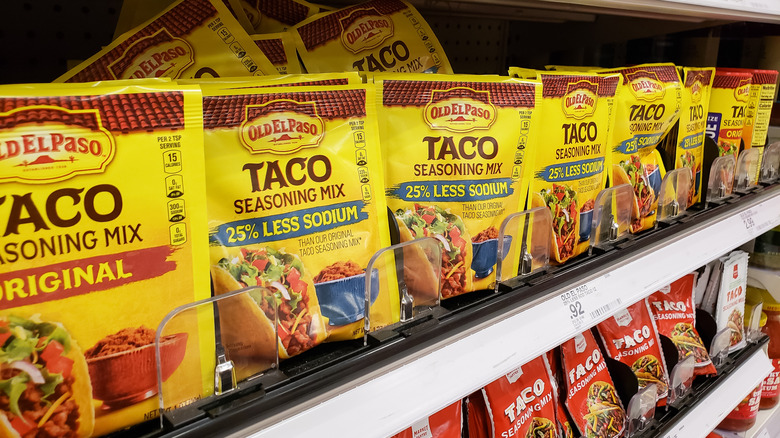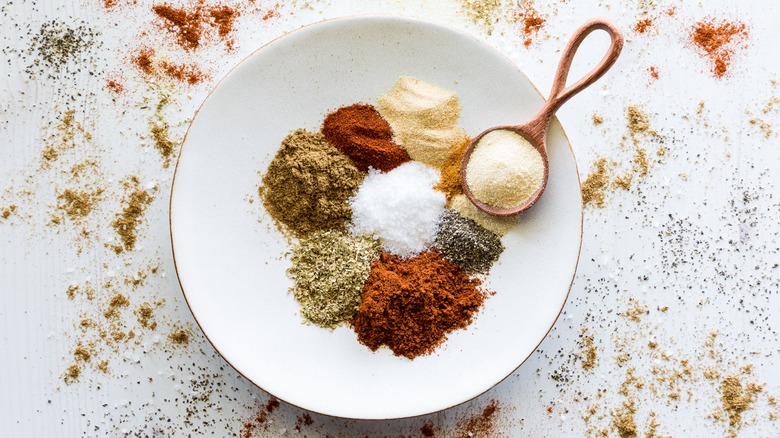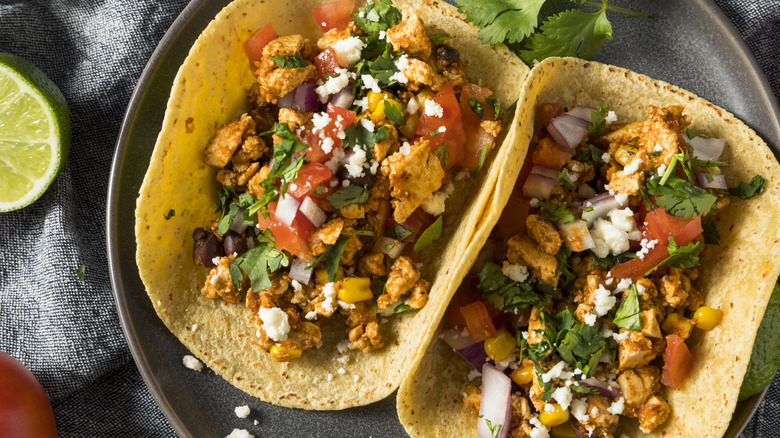What Is Taco Seasoning Really Made Of?
Taco seasoning should be a little smoky, a little spicy, but most importantly, it should be a one-stop flavor shop. Whether you buy packets to have on hand or make your own blend, any number of herbs and spices can go into creating a craveable taste. Powdered chili peppers of some sort are definitely a must, and other spices like cumin, paprika, garlic powder, onion powder, and dried oregano are common features. Store-bought blends will also typically include salt and fillers.
McCormick taco seasoning contains chili pepper, paprika, oregano, salt, onion, and garlic as well as potato starch and unspecified natural flavors. Old El Paso's blend leads with cornstarch on the ingredients label followed by maltodextrin, salt, chili pepper, onion powder, and sugar. There is also a small amount of unspecified spices, anti-caking additives, and vegetable oil. While the cornstarch here does not do anything for the flavor, it does help with the texture. Cornstarch thickens any liquid — including the pan juices from taco meat or vegetables — which makes for a sumptuous sauce. Taco Bell's taco seasoning is pretty similar but uses wheat flour instead of cornstarch. Lawry's has the interesting additions of lactose and cocoa powder.
How to make your own taco seasoning
Take inspiration from your favorite store-bought brand, or come up with your ideal combination. When crafting your own mix, it is always a good idea to taste each ingredient individually to get a sense of what each component can bring to the table. Use any kind of powdered dried chiles that you like. If you want to keep it super mild, stick to sweet paprika, ancho, or pasilla powders. Go for chipotle, guajillo, kashmiri, or hot paprika for medium heat, or be bold with something like cayenne, morita, or chile de arbol. Keep in mind that products labeled as "chili powder" are usually a mix of different kinds of chilies and sometimes even have additional spices.
Add cumin for earthy nuttiness, coriander for citrus florals, or oregano for peppery herbaceousness. Stir in classic onion and garlic powder to your liking, or get creative with dehydrated tomato powder, mushroom powder, dry bouillon, or monosodium glutamate (MSG). A touch of sugar can be a nice foil to the heat, and a bit of cornstarch is also good if you like that glossy, saucy, cohesive texture in your taco filling. The decision to add salt totally depends on how you want to use your seasoning. If you tend to stick to the same few tried-and-true dishes, adding salt to taste right in your seasoning blend can save you a step down the line. Otherwise, keep it salt-free for more flexibility.
Creative ways to use taco seasoning
Ground beef taco meat, crunchy taco shells, and all the fixings like iceberg lettuce, diced tomatoes, sour cream, and shredded cheddar cheese are classic for a reason, but feel free to use any kind of ground protein. You can even trade in the tortilla to make a fully loaded taco salad. Or replace your avocado pit with spicy ground beef for silky taco bowls. In addition to meat, tempeh, tofu, or finely chopped veggies like mushrooms, summer squash, and cauliflower would all be great here too.
Of course, taco seasoning does not have to be reserved just for tacos. Use it to make a Tex-Mex lasagna, enchilada sauce, tortilla soup, pulled pork, or refried beans. Add taco seasoning into a mixture of softened cream cheese and sour cream to make a delicious dip, or dust it onto buttered popcorn for your next movie night.
When you are not using it, store your homemade taco seasoning or any leftovers from a store-bought packet in an air-tight container. Keep it in a cool, dark place as both light and heat can cause dry spices to degrade more quickly.



